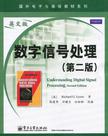数字信号处理
出版时间:2010-7 出版社:电子工业出版社 作者:Richard G.Lyons 页数:289 译者:张建华,徐晓东
Tag标签:无
前言
2001年7月间,电子工业出版社的领导同志邀请各高校十几位通信领域方面的老师,商量引进国外教材问题。与会同志对出版社提出的计划十分赞同,大家认为,这对我国通信事业、特别是对高等院校通信学科的教学工作会很有好处。 教材建设是高校教学建设的主要内容之一。编写、出版一本好的教材,意味着开设了一门好的课程,甚至可能预示着一个崭新学科的诞生。20世纪40年代MIT林肯实验室出版的一套28本雷达丛书,对近代电子学科、特别是对雷达技术的推动作用,就是一个很好的例子。 我国领导部门对教材建设一直非常重视。20世纪80年代,在原教委教材编审委员会的领导下,汇集了高等院校几百位富有教学经验的专家,编写、出版了一大批教材;很多院校还根据学校的特点和需要,陆续编写了大量的讲义和参考书。这些教材对高校的教学工作发挥了极好的作用。近年来,随着教学改革不断深入和科学技术的飞速进步,有的教材内容已比较陈旧、落后,难以适应教学的要求,特别是在电子学和通信技术发展神速、可以讲是日新月异的今天,如何适应这种情况,更是一个必须认真考虑的问题。解决这个问题,除了依靠高校的老师和专家撰写新的符合要求的教科书外,引进和出版一些国外优秀电子与通信教材,尤其是有选择地引进一批英文原版教材,是会有好处的。 一年多来,电子工业出版社为此做了很多工作。他们成立了一个“国外电子与通信教材系列”项目组,选派了富有经验的业务骨干负责有关工作,收集了230余种通信教材和参考书的详细资料,调来了100余种原版教材样书,依靠由20余位专家组成的出版委员会,从中精选了40多种,内容丰富,覆盖了电路理论与应用、信号与系统、数字信号处理、微电子、通信系统、电磁场与微波等方面,既可作为通信专业本科生和研究生的教学用书,也可作为有关专业人员的参考材料。此外,这批教材,有的翻译为中文,还有部分教材直接影印出版,以供教师用英语直接授课。希望这些教材的引进和出版对高校通信教学和教材改革能起一定作用。 在这里,我还要感谢参加工作的各位教授、专家、老师与参加翻译、编辑和出版的同志们。各位专家认真负责、严谨细致、不辞辛劳、不怕琐碎和精益求精的态度,充分体现了中国教育工作者和出版工作者的良好美德。 随着我国经济建设的发展和科学技术的不断进步,对高校教学工作会不断提出新的要求和希望。我想,无论如何,要做好引进国外教材的工作,一定要联系我国的实际。教材和学术专著不同,既要注意科学性、学术性,也要重视可读性,要深入浅出,便于读者自学;引进的教材要适应高校教学改革的需要,针对目前一些教材内容较为陈旧的问题,有目的地引进一些先进的和正在发展中的交叉学科的参考书;要与国内出版的教材相配套,安排好出版英文原版教材和翻译教材的比例。我们努力使这套教材能尽量满足上述要求,希望它们能放在学生们的课桌上,发挥一定的作用。 最后,预祝“国外电子与通信教材系列”项目取得成功,为我国电子与通信教学和通信产业的发展培土施肥。也恳切希望读者能对这些书籍的不足之处、特别是翻译中存在的问题,提出意见和建议,以便再版时更正。
内容概要
《数字信号处理(第2版)(英文版)》在Richard G. Lyons所著Understanding Digital Signal Processing , Second。Edition的基础上进行了改编,针对通信类学校本科教学大纲,删除了教学中一般不涉及的内容,调整了章节顺序,并增加了z反变换、滤波器结构、线性相位FIR滤波器及其结构、模拟滤波器简介的内容,使教材内容更加完整。全书在概述了离散序列和系统的定义和实例之后,详细讨论了离散系统的特性、信号的离散化和离散卷积、z变换、离散时间傅里叶变换和离散傅里叶变换、快速傅里叶变换、数字滤波器结构以及有限和无限脉冲响应数字滤波器的设计等基本概念和基本理论。书中涉及的数学知识以简明形式给出,深入浅出,易于理解。《数字信号处理(第2版)(英文版)》每章都增加了例题、习题和MATLAB例题,以便加强对每章内容的理解和掌握。 《数字信号处理(第2版)(英文版)》可作为理工类大专院校电子、计算机、通信等专业的本科生双语教学教材,对于DSF,领域的工程技术人员也有很好的参考价值。
作者简介
莱昂斯(Richard G.Lyons),毕业于美国加州阿克隆大学,曾任国家安全局和TRW(天合)汽车集团公司众多DSP系统的首席硬件工程师,负责系统设计、开发、测试和安装。曾任教于加利福尼亚大学圣塔克鲁兹分校,并发表过很多有关DSP的文章。作为IEEE Signal Processing Magazine的副主编,开设了DSP Tips&Tricks专栏并负责编辑。
书籍目录
Chapter 1 Discrete Sequences and Systems 11.1 Discrete Sequences and Their Notation 11.1.1 Discrete-time Signals 21.1.2 Frequently Used Discrete Sequences 71.2 Signal Amplitude, Magnitude, Power 91.3 Signal Processing Operational Symbols 101.4 Introduction to Discrete Linear Time-Invariant Systems 121.5 Discrete Linear Systems 121.5.1 Example of a Linear System 121.5.2 Example of a Nonlinear System 141.6 Time-Invariant Systems 161.6.1 Example of a Time-Invariant System 161.7 The Commutative Property of Linear Time-Invariant Systems 171.8 The Causality Property of Linear Time-Invariant Systems 181.9 The Stability Property of Linear Time-Invariant Systems 181.10 Analyzing Linear Time-Invariant Systems 191.11 Problems 201.12 MATLAB Applications 221.12.1 Applications 221.12.2 Examples 231.12.3 Exercises 24Chapter 2 Periodic Sampling 252.1 Aliasing: Signal Ambiguity in the Frequency Domain 252.2 Sampling Low-Pass Signals 292.3 A Generic Description of Discrete Convolution 322.3.1 Discrete Convolution in the Time Domain 332.3.2 The Convolution Theorem 362.3.3 Applying the Convolution Theorem 392.4 Problems 422.5 Matlab Applications 432.5.1 Applications 432.5.2 Examples 442.5.3 Exercises 46Chapter 3 Z-Transform 473.1 The z-Transform 473.1.1 Poles and Zeros on the z-Plane and Stability 493.1.2 The ROC of z-Transform 503.1.3 The Properties of z-Transform 533.2 The Inverse z-Transform 553.2.1 General Expression of Inverse z-Transform 553.2.2 Inverse z-Transform by Partial-Fraction Expansion 583.3 Problems 613.4 MATLAB Applications 633.4.1 Applications 633.4.2 Examples 643.4.3 Exercises 67Chapter 4 The Discrete Fourier Transform 684.1 Interpreting the DFT 694.2 Understanding the DFT Equation 714.2.1 DFT Example 1 744.3 DFT Properties 814.3.1 DFT Symmetry 814.3.2 DFT Linearity 834.3.3 DFT Magnitudes 834.3.4 DFT Frequency Axis 844.3.5 DFT Shifting Theorem 854.4 Inverse DFT 874.5 DFT Leakage 884.6 Windows 944.7 DFT Resolution, Zero Padding, and Frequency-Domain Sampling 1014.8 Frequency Response 1044.9 Problems 1064.10 Matlab Applications 1074.10.1 Applications 1074.10.2 Examples 1084.10.3 Exercises 111Chapter 5 The Fast Fourier Transform 1125.1 Relationship of the FFT to the DFT 1125.2 FFT Alogrithm 1135.3 Derivation of the Radix-2 FFT Algorithm 1145.4 FFT Input/Output Data Index Bit Reversal 1205.5 Radix-2 FFT Butterfly Structures 1215.6 Efficiently Performing the FFT of Real Sequences 1275.6.1 Performing Two N-Point Real FFTs 1275.6.2 Performing a 2N-Point Real FFT 1335.7 Discrete Convolution using FFT 1375.7.1 Overlap-added 1385.7.2 Overlap-saved 1385.8 IFFT Algorithm 1405.9 Problems 1435.10 Matlab Applications 1445.10.1 Applications 1445.10.2 Examples 1445.10.3 Exercises 146Chapter 6 Filter Structure 1476.1 Block Structure 1476.2 Mason and Transpose Theorem 1496.2.1 Mason s Rule 1496.2.2 Transpose Theorem 1506.3 Example of Filter Structures 1516.3.1 IIR Filter Structure 1516.3.2 FIR Direct Structure 1586.3.3 FIR Cascade Structure 1586.4 Problems 1596.5 Matlab Applications 1626.5.1 Applications 1626.5.2 Examples 1636.5.3 Exercises 167Chapter 7 Finite Impulse Response Filters 1687.1 An Introduction to Finite Impulse Response (FIR) Filters 1697.2 Properties of FIR Filters 1727.2.1 Convolution in FIR Filters 1727.2.2 Linear phase FIR Filter 1817.2.3 Linear Phase FIR Filter Structure 1887.2.4 FIR Filter Poles and Zeros 1947.3 Low-Pass FIR Filter Design 1967.3.1 Window Design Method 1977.3.2 Windows Used in FIR Filter Design 2047.3.3 Examples to Design Linear Phase Low-Pass FIR Filter 2107.4 Examples to Design Other Types Linear Phase FIR Filter 2157.5 Problems 2207.6 Matlab Exercises 2237.6.1 Applications 2237.6.2 Examples 2237.6.3 Exercises 224Chapter 8 Infinite Impulse Response Filters 2268.1 An Introduction to Infinite Impulse Response Filters 2278.2 The Laplace Transform 2298.2.1 Poles and Zeros on the s-Plane and Stability 2348.3 Analog Low-Pass Filters 2398.3.1 Introduction 2408.3.2 Approximation of analog filter characteristics 2408.3.3 Butterworth Approximation 2428.3.4 Chebyshev Approximation 2478.4 Impulse Invariance IIR Filter Design Method 2538.4.1 Impulse Invariance Design Method 1 Example 2588.4.2 Impulse Invariance Design Method 2 Example 2608.5 Bilinear Transform IIR Filter Design Method 2668.5.1 Bilinear Transform Design Example 2718.6 Low-Pass IIR Filter Design 2748.6.1 Example of Low-Pass IIR Digital Filter Design 2748.6.2 a Brief Comparison of IIR and FIR Filters 2778.7 Other Types IIR Filter Design 2788.8 Problems 2848.9 Matlab Exercises 2868.9.1 Functions of IIR Design 2868.9.2 Examples 2878.9.3 Exercises 288
编辑推荐
通俗、易于理解的语言风格和内容,丰富了z变换、DTFT变换等DSP重要内容,强调结合工程应用的DSP例子并给出解决思路。给出了滤波器结构的实现手段,丰富、直观的大量DSP例题和方案,增加了习题和DSP编程的内容。
图书封面
图书标签Tags
无
评论、评分、阅读与下载
